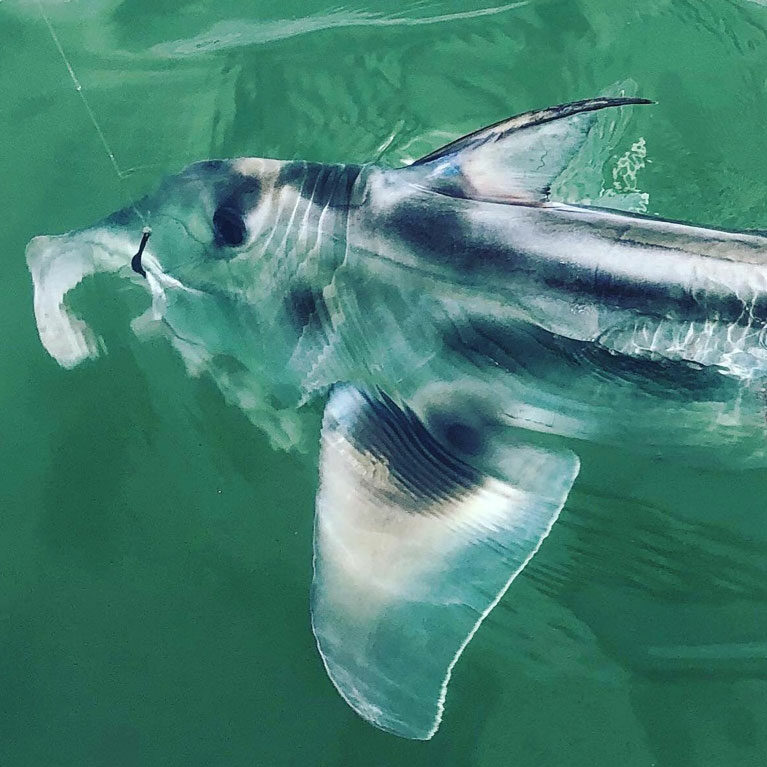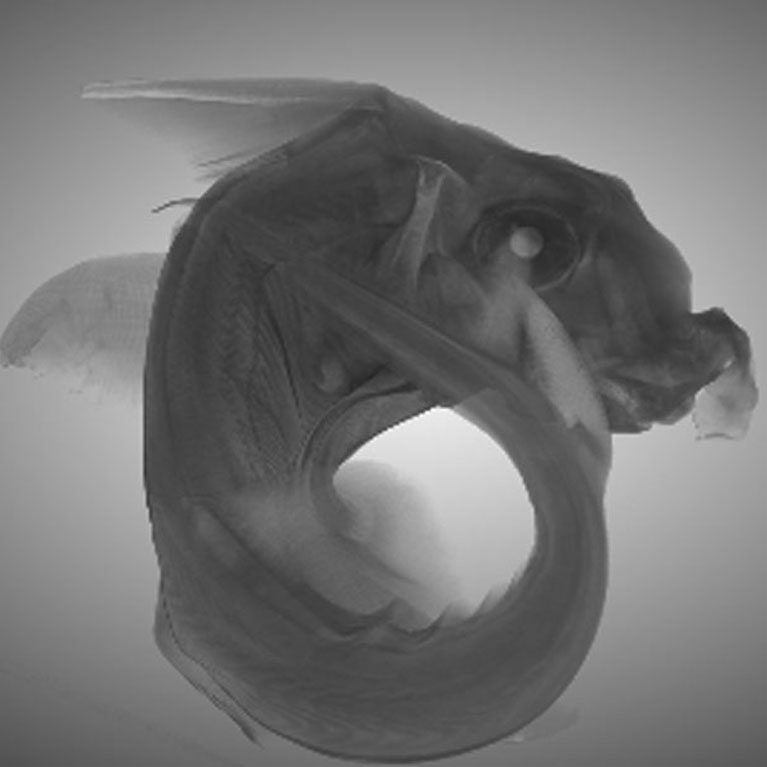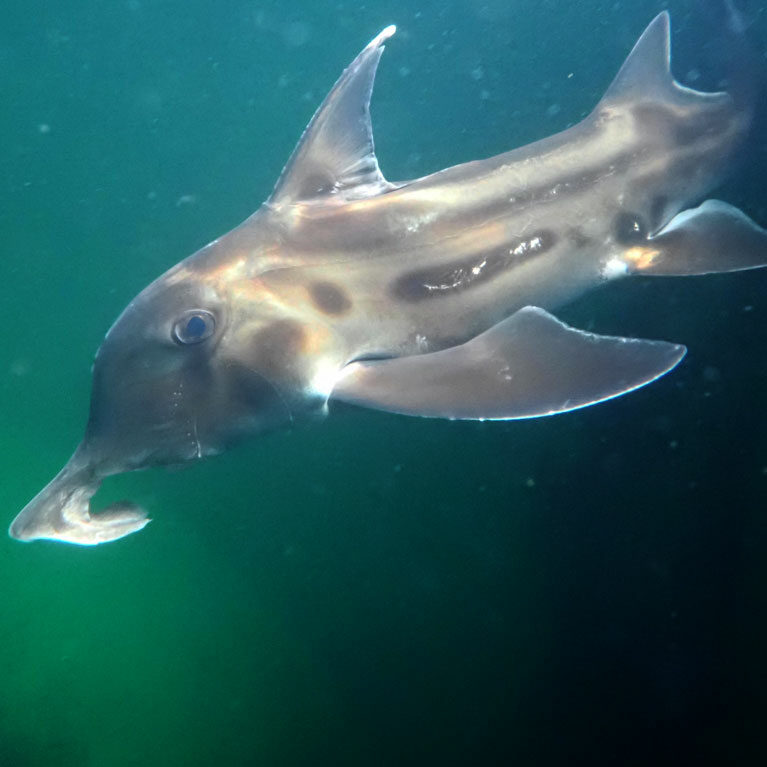The ghost of oceans future
As evidence increases to show our noisy oceans are impacting marine mammals, studies are expanding to explore how other species are coping – or not. Lucille wants to understand how the Australian ghost shark – a deep sea species accustomed to low light that relies on its hearing to feed and navigate – is affected. She will describe ghost shark hearing using 3D bioimaging techniques and predict their hearing abilities. Not only will she be describing their hearing system, but Lucille will also test the impact of the noises from human activities on these sharks to understand how we might change their behaviour.
Map keywords: Noise pollution Australian ghostshark.
Growing up in landlocked Switzerland, I have always regarded the ocean as a place of wonder and mystery that I could explore only when on holiday. This admiration developed into a passion as soon as I saw marine animals for myself. I had learnt to dive in the cold freshwater lakes of Switzerland, so my first dives in the sea were real eye-openers. I felt honoured to be able to witness this ecosystem teeming with life. Sharks especially, with their magnificent presence, have always fascinated me. I was eager to learn more and studied biology at the University of Lausanne,...




Impacts of underwater noise on the Australian Ghost shark
To profile the soundscape of the Australian ghost shark’s most significant and vulnerable nursery and to describe the acoustic ecology of the species. My multidisciplinary approach will use novel bio-imaging techniques combined with behavioural analyses to describe the inner ear and auditory sensitivity of this shark and the impact of noise pollution on its physiology and behaviour.
Ghost sharks normally live at great depths, migrating to shallower waters to reproduce, and are predicted to rely heavily on their hearing. Noise pollution is increasing in the oceans, but there is no information about its potential effect on these fish. My research investigates the behaviour and physiology of ghost sharks to learn about their hearing system, predict their hearing ability and assess their vulnerability to noise generated by humans.
The acoustic environment of the oceans is changing rapidly due to an increase in noise from shipping, mining and other human activities, which has a profound effect on marine animals, including fish. Noise has been shown to cause physiological stress and changes in behaviour and metabolism and it can lead to physical damage to the inner ear.
The Australian ghost shark or elephant fish Callorhinchus milii belongs to a small group of cartilaginous fish known as the chimaeras. As they live mainly at depths where there is little light, chimaeras probably rely heavily on their hearing to feed, navigate and migrate. However, their auditory range is very likely to overlap with the low sound frequencies produced by the sources of human-made noise.
Australian ghost sharks are targeted by fisheries for food and taken as bycatch. Despite strict quotas, historical catch assessments reveal a decline in stocks, particularly in populations in south-eastern Australia. Because its reproductive rate is low and it produces few offspring, this species is particularly vulnerable to overfishing. Sexually mature adults migrate seasonally from depths of more than 200 metres (650 feet) to the shallower waters of Western Port Bay in Victoria to reproduce. This area is recognised as the most significant nursery for Australian ghost sharks in Australia. Over the past few years shipping traffic has increased significantly and numerous gas import terminal and pipeline projects have been proposed.
This study will assess the current and predicted levels of noise (shipping, mining, pile driving and seismic surveys) and the health and acoustic behaviour of Australian ghost sharks, a species that is known to come only to this region to lay its eggs and reproduce. Our findings will help to guide policies on environmental and fisheries management and the development of sound-based mitigation strategies to protect this vulnerable species.
- To assess the effect of anthropogenic noise on the behaviour and physiology of ghost sharks in laboratory conditions. Different sources of human-made sounds, including recordings from known locations frequented by this species, will be tested to investigate the potential impacts of noise on these animals.
- To describe the hearing system of the Australian ghost shark with state-of-the-art 3D bio-imaging techniques, including microcomputed tomography and magnetic resonance imaging on tissue donated as a result of bycatch. This will enable me to predict the shark’s hearing ability.
RESULTS:
Our results show that Australian ghost sharks (Callorhinchus milii) possess well developed sensory systems, and, in particular, large otic capsules containing the inner ears. We show that the shallow bays in Victoria, Australia, where Australian ghost sharks are known to lay their eggs, typically represent soundscapes heavily impacted by the sounds of tidal currents and wave action (i.e., geophony). However, many of the passageways to reach these bays are visited by numerous shipping vessels and motorboats on their way back and forth to Melbourne, ensonifying the areas with boat
noise. Finally, our behavioural tests with captive adult Australian ghost sharks reveal that these animals increase their respiratory rate when exposed to boat noise, an overt sign of stress. These results reveal the importance of sound for this species and provides the first evidence that present levels of anthropogenic boat noise in these areas may have
detrimental effects on individuals. This suggests that action should be taken in order to preserve these noteworthy areas selected as nursery grounds for ghost sharks. Our results will inform and hopefully help guide future fisheries and environmental management policies, in order to protect this unique species.

